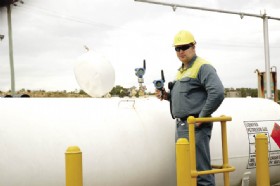Emersonís Smart Wireless Solution Reliably Monitors Critical Fuel and Feedstock Delivery at BP Bitumen

BP Bitumen found Emersonís Smart Wireless technology to be a cost-effective and reliable method of m
Emerson Process Managementís Smart Wireless technology has been successfully used to overcome a fuel supply outage at BP Bitumen near Brisbane, Australia. Wireless instruments normally monitor the pipeline integrity of transfer lines from the nearby BP refinery and report exceptional conditions to control room operators via the easy-to-use self-organising wireless network. The wireless solution showed its flexibility recently when two wireless transmitters were quickly deployed to manage fuel delivery from temporary LPG tanks rushed into service during a refinery shutdown of the normal fuel system.
Officials at BP Bitumen recognised Smart Wireless as a cost-effective and reliable method of monitoring the temporary fuel gas supply system. The plant normally fires natural gas in a heater to maintain a hot oil network at 280į C. All plant bitumen lines have hot oil tracing to keep the viscous product flowing. Even a temporary interruption to the supply of fuel to the heater can adversely effect operations because if the heater shuts down, the plant cools very quickly. If the plant goes completely cold, it can take three to four days to restart. The cost of sourcing replacement product to meet existing contracts could be as much as $150,000 AUD (Ä77,000 Eur) for a fuel outage of one weekís duration. For this reason, a close visual watch had to be maintained on the temporary LPG supply to monitor it 24 hours per day. The Smart Wireless solution was implemented to monitor the transfer lines in May 2008 and fuel monitoring was put into service shortly thereafter.
The Smart Wireless field network solution included two Rosemountģ wireless pressure transmitters that were installed to monitor the fuel delivery from the LPG tanks. With relatively little time to prepare for the natural gas outage, it was not possible to size the temporary LPG system for the maximum firing capacity of the hot oil heater. Without careful monitoring, the heaterís burner control system could call for more gas than was available, sucking the fuel line dry and tripping the heater. However, with the wireless pressure transmitters in place, the burner control system could monitor the LPG supply pressure and avoid the trip scenario. The wireless monitoring of the LPG fuel delivery kept the bitumen plant running, saving the company $20,000 AUD (Ä10,250 Eur) per day in lost production. The wireless solution also provided safe remote oversight of the fuel supply instead of continuous operator monitoring at the LPG facility. The plant operated successfully in this way for the duration of the week-long outage.
In addition to the fuel monitoring, three Rosemount wireless temperature transmitters are placed along the plantís bitumen transfer lines to monitor flow of the hot (170oC) bitumen. These instruments transmit status continuously, allowing immediate action if needed to maintain the flow of bitumen to the plant.
"This wireless network monitors pipeline integrity, helping to ensure that no issues go unnoticed for any length of time," according to Matthew James, Operations Manager at the BP Bitumen facility. "If we had not had the wireless installations, we could not have reacted so quickly to the fuel outage and that could have shut us down for over a week. As a tool to help troubleshoot unusual process conditions anywhere on the plant, theyíre indispensable."
Each field device in Emersonís self-organising wireless technology acts as a router for other nearby devices, re-transmitting messages until they reach the networkís Smart Wireless Gateway, which channels the incoming data to a control point. If there is an obstruction, transmissions are simply re-routed along the mesh network until a clear path to the gateway is found. As conditions change or new obstacles are encountered in a plant, such as temporary scaffolding, new equipment, or a parked construction trailer, these wireless networks simply reorganise and find a way to deliver their messages.
All of this happens automatically, without any involvement by the user, providing redundant communication paths and better reliability than direct, line-of-sight communications between individual devices and a receiver. This self-organising technology optimises data reliability while minimising power consumption. It also reduces the effort and infrastructure necessary to set up a successful wireless network, because up to 99 wireless devices can be served by one gateway. New instruments can normally be added to a network in just minutes.
"This wireless concept is not a fad or gimmick," James said. "It really works, and the operating range is amazing. It is a long distance from the temporary LPG bullets to the control room. The fact that we could transmit that far and do so reliably without a single loss of signal is quite magical."
For further information on Emersonís Smart Wireless solution, go to
www.EmersonProcess.co.uk/SmartWireless

| Telephone: | 0870 240 1978 |
| Email: | uksales@emerson.com |
| Website: | https://www.emerson.com/en-gb/automation/home |
| More information on the Emerson Process Management Ltd BVAA Member Directory Page |
Search related valve / actuator articles: Emerson Process Management LtdIssue 9Wireless







-web.jpg)





